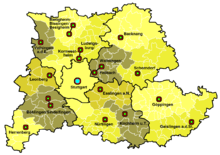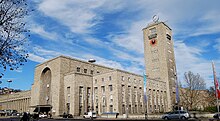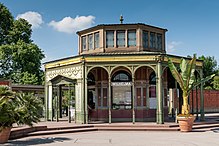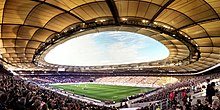Stuttgart
Stuttgart (German pronunciation:/^^^(![]() listen); in Spanish and in disuse, Estucardia) is the capital of the German federated state of Baden-Wurtemberg. With 605,997 inhabitants, Stuttgart is the largest city in Baden-Wurtemberg and the sixth in Germany. In addition, it is the seat of the parliament of its Bundesland and its corresponding government, as well as other political authorities and the federal administration, also counting on the status of city-distrito, unified by a president. It is also the seat of the evangelical bishop of Wurtemberg and a Catholic bishop (Bistum Rottenburg-Stuttgart).
listen); in Spanish and in disuse, Estucardia) is the capital of the German federated state of Baden-Wurtemberg. With 605,997 inhabitants, Stuttgart is the largest city in Baden-Wurtemberg and the sixth in Germany. In addition, it is the seat of the parliament of its Bundesland and its corresponding government, as well as other political authorities and the federal administration, also counting on the status of city-distrito, unified by a president. It is also the seat of the evangelical bishop of Wurtemberg and a Catholic bishop (Bistum Rottenburg-Stuttgart).
The city is the economic and cultural center of the federal state, and is marked by the tradition of mining and iron and steel. It has two universities, technical schools and is the headquarters of several research institutes, such as the German Aerospace Center (DLR), the Fraunhofer-Gesellschaft or the Max Planck Society.
Stuttgart is the gateway to the Black Forest and the Swabian Alb, and sits in a valley flanked by vine-filled mountains known as the "Kessel", the caldera. The port lies northeast of the city, on the banks of the Neckar river. The largest and closest large German cities to Stuttgart are: Frankfurt am Main (240 km northwest), Munich (approximately 220 km southeast of Stuttgart) and Karlsruhe (80 km northwest).
Traditionally, Stuttgart is considered "the city where the automobile was born", and is home to two museums dedicated to its history: the Mercedes-Benz Museum and the Porsche Museum.
Toponymy
Stuttgart comes from the German word Stutengarten (meaning stud), since the city has its origins around the former stables of Duke Liudolf of Swabia. His coat of arms therefore has a mare. The Porsche automobile brand, originally from this area, includes this shield in its emblem.
History
The district of Cannstatt constitutes the oldest part of the city of Stuttgart. C. a Roman citadel dates back, one of the most important positions in the area, being located on the banks of the Neckar and at the crossroads. With the invasion of the Alemanni in 260 AD. C. ended the Roman presence in Stuttgart. There are no traditions in Cannstatt of the barbarian peoples, who came to stay due to the strategic situation but the colonies kept their traditions.
Presumably, Stuttgart continued to grow during the Hungarian invasions (Ungarneinfälle) between 926 and 948 in the Nessenbachtal and the stud farms (or Stutengarten, hence the name Stuttgart). The growth of the city It is attributed to Count Liudolf of Swabia, after 945 AD. C. Since then the growth has been towards the sides of the facilities of Count Liudolf.
New archaeological excavations that are being carried out both in the collegiate church and in the old castle show us that there were no green meadows when the city was founded: at least since the Merovingians, since simple peasants settled here. A burial under the collegiate church completes the scant information there is about the state of the city during the Merovingian occupation. From the Carolingian period, some wells and houses remain.
The city was close to the horse farms of the County of Baden, as well as the cities of Backnang and Besigheim, which belong to the County of Württemberg. With Countess Irmengard of Baden, the Lichtenhal monasteries remained in Baden-Baden; she was also the owner of the Nesenbachtal.
The Marchioness of Baden was to the west of her enemies, the Marquises of Württemberg, later Counts. Hermann V of Baden rose to power in the city in 1219. Then it was the Wurttembergs who took the city, and a dynasty later they married and installed all the pomp of Wurttemberg in the center of the city. Until 1918 Stuttgart was the capital and residence of the Wurttembergs: until 1496 it was the county of Wurttemberg, after the counts, until 1803 it was a principality and from 1806 the kingdom of Wurttemberg and after 1918 the Free State of Wurttemberg.
At the end of May 1849, after the rejection of a congress of deputies by the Prussian King Frederick William IV, the National Assembly of Frankfurt moved to Stuttgart thanks to an invitation from the Minister of Justice Friedrich Römer, belonging to the Württemberg family.
19th century
In 1806, Stuttgart achieved a rise in rank in the course of the Napoleonic Wars and the consequent establishment of the Confederation of the Rhine. The city became the capital of the Kingdom of Württemberg, which expanded to include the areas of New Württemberg. After the existence of the new state of Württemberg was confirmed with the conclusion of the Congress of Vienna in 1815, Stuttgart experienced a gradual rise in the century. XIX.
In the 1880s and 1890s, Gottlieb Daimler (1834-1900) laid the foundations for the first automobiles in Cannstatt, near Stuttgart, and in 1887 founded the Daimler-Motoren-Gesellschaft. After a fire, the new engine plant was built in Untertürkheim (one of Stuttgart's districts) in 1903.
Since 1945
With the end of World War II in Europe in 1945, Stuttgart was destroyed after being bombed by the Allies. Although the historic center was extensively destroyed, many historical monuments and buildings were rebuilt, such as: the Fruchtkasten, one of the oldest buildings; the Stiftskirche church, and the Old Castle today converted into the National Museum of Wurtemberg.
Following the occupation of Stuttgart by French troops, there were at least 1,389 rapes in Stuttgart. On July 8, 1945, French forces handed over Stuttgart to American soldiers after being asked to do so; thereafter the city belonged to the US occupation zone. Stuttgart was the capital of the state of Württemberg-Baden, which existed from 1945 to 1952.
The military administration set up camps in Stuttgart to house so-called displaced persons (PDs). Most of the PDs were former Central and Eastern European forced laborers in industrial operations in the region. The camp was closed in 1949, the remaining PD relocating to a PD camp in Heidenheim an der Brenz.
In 1948, the city's application to become the new capital of the yet-to-be-founded Federal Republic failed. In addition to Stuttgart, the cities of Frankfurt am Main, Kassel and Bonn were also submitted. In 1956 the construction of the Stuttgart City Hall, which is the seat of the city administration, was completed. The distinctive feature of the building is the 60.5 meter high clock tower. The previous building burned down in 1944 during the war, however parts of the two side wings were preserved during reconstruction.
Within the European Union (EU), the city hosted the European Summit from June 17 to 19, 1983. In it, the members of the European Council signed a Solemn Declaration on the European Union (EU), and they examined the horizon of the accession of Spain and Portugal to the EU. In addition, in April 1999 the Third Euro-Mediterranean Conference was held in Stuttgart, with the participation of Libya for the first time as a special guest.
| Districts of the interior |
|---|
| Stuttgart-Mitte (10), Stuttgart-Nord (11), Stuttgart-Ost (8), Stuttgart-Süd (7), Stuttgart-West (9) |
| External districts |
| Bad Cannstatt (18), Birkach (3), Botnang (1), Degerloch (5), Feuerbach (8), Hedelfingen (4), Möhringen (9), Mühlhausen (5), Münster (1), Obertürkheim (2), Plieningen (5), Sillenbuch (3), Stammheim (2), Untertürkheim (8), Vaihingen (12), Wanghausen (1), Weilim |
Politics
Since November 2020, the mayor (Oberbürgermeister) of Stuttgart is Frank Nopper of the CDU (Christian Democratic Union).
At the end of World War II, French administrators appointed independent politician Arnulf Klett as mayor, a role he fulfilled without interruption until his death in 1974. Since then, Stuttgart has been governed primarily by the CDU. One former mayor was Manfred Rommel, son of the most famous German field marshal of World War II, Erwin Rommel.
As the capital of Baden-Württemberg, Stuttgart is an important political center in Germany and the seat of the State Parliament, or Landtag, as well as all of Baden-Württemberg's state departments.
Geography
Stuttgart is located in the center of the state of Baden-Württemberg, in the middle of a long series of hills. The city center is located between valleys and vineyards, which is why the city is nicknamed Stuttgarter Kessel ("The Stuttgartin Pot"). Stuttgart is located along the Neckar River. The German city borders the Neckar basin to the north, Glemswald and the Gäu to the west, the Schurwald corridor to the east and the Schönbuch nature park to the south. To the southeast flows the Neckar and the city Esslingen am Neckar is situated.
The city is located at an elevation of 207 meters above sea level. Stuttgart rises by the Birkenkopf (511 m) in the Rand depression; also raised by the Wirtemberg (411 m) above the Neckar valley and by the Heiner forest (395 m).
Region planning
The city is located in the center of the Stuttgart Region. The districts of Esslingen, Göppingen, Böblingen, Ludwigsburg and Rems-Murr-Kreis belong to the region, as well as the municipality of Heilbronn (north of Stuttgart) and to the south of the region the cities of Reutlingen and Tübingen. All these municipalities and others adjacent to the German city form the metropolitan region of Stuttgart, which divides the Bundesland of Baden-Württemberg into 14 different zones.
The European metropolitan region of Stuttgart also integrated the cities of Ditzingen, Filderstadt, Gerlingen, Korntal-Münchingen and Leinfelden-Echterdingen. The Stuttgart zone controls the cities of Backnang, Bietigheim-Bissingen/Besigheim, Böblingen/Sindelfingen, Esslingen am Neckar, Geislingen an der Steige, Göppingen, Herrenberg, Kirchheim unter Teck, Leonberg, Ludwigsburg/Kornwestheim, Nürtingen, Schorndorf, Vaihingen an der Enz and Waiblingen/Fellbach.
Neighboring municipalities
The following cities border the city of Stuttgart; the order starts from the northeast and follows the direction of clockwise:
Fellbach, Kernen im Remstal (all in the urban district of Rems-Murr), Esslingen am Neckar, Ostfildern, Neuhausen auf den Fildern, Filderstadt and Leinfelden-Echterdingen (in the rural district —Landkreis — of Esslingen), Sindelfingen and Leonberg (in the landkreis of Böblingen), as well as Gerlingen, Ditzingen, Korntal-Münchingen, Möglingen, Kornwestheim and Remseck am Neckar (all in the landkreis i> of Ludwigsburg).
Climate
Because it is located in a depression and because of the crops, in Stuttgart we find a mostly warm climate, although winters tend to be frosty. The Black Forest and the Swabian and Frankish forests relax the temperatures with the shadows of their trees. The climate and the slope in which Stuttgart is located facilitates the appearance of viticulture.
In summer, thermal inversion occurs. That is why it is possible that in summer the temperature in the Königstraße (the main street of Stuttgart) and in the surroundings of the Schlossplatz (the main square) reaches temperatures of 30-35º at noon.
| Month | Ene. | Feb. | Mar. | Open up. | May. | Jun. | Jul. | Ago. | Sep. | Oct. | Nov. | Dec. | Annual |
|---|---|---|---|---|---|---|---|---|---|---|---|---|---|
| Temp. max. abs. (°C) | 18.1 | 21.0 | 25.6 | 30.8 | 34.5 | 39.5 | 40.8 | 39.7 | 35.6 | 30.8 | 23.3 | 19.5 | 40.9 |
| Average temperature (°C) | 3.7 | 5.6 | 10.8 | 16.8 | 22.0 | 24.8 | 26.8 | 26.6 | 21.7 | 15.6 | 8.3 | 4.4 | 14.0 |
| Average temperature (°C) | -6.5 | -2.5 | 6.2 | 12.2 | 16.6 | 19.7 | 23.9 | 21.3 | 15.2 | 10.9 | 5.3 | -3.6 | 11.4 |
| Temp. medium (°C) | -10.5 | -4.8 | 2.2 | 7.8 | 11.3 | 15.4 | 18.7 | 16.6 | 13.8 | 7.9 | -4.4 | -8.6 | 7.0 |
| Temp. min. abs. (°C) | -28.5 | -21.3 | -16.0 | -6.2 | -3.9 | 3.3 | 6.0 | 5.6 | 1.2 | -8.3 | -19.9 | -22.5 | -28.5 |
| Total precipitation (mm) | 46.2 | 35.5 | 38.6 | 49.6 | 85.7 | 86.8 | 86.1 | 69.1 | 57.1 | 58.8 | 49.8 | 50.4 | 718.7 |
| Hours of sun | 79.8 | 96.4 | 137.9 | 177.0 | 236.5 | 255.8 | 272.4 | 258.1 | 190.4 | 144.6 | 74.1 | 60.4 | 1983.4 |
| Source: Data derived from Deutscher Wetterdienst | |||||||||||||
Demographics
In 1875 Stuttgart surpassed the
Religion
In 2017, 24.1% of the inhabitants of Stuttgart were Protestants and 23.1% Catholic, the remaining 52.8% belonged to other religions or were non-denominational.
Economy
The Stuttgart area is known for its high-tech industry. The city is home to the ninth largest exhibition center in Germany, the Stuttgart Trade Fair, which is located on the outskirts of the city, next to the Stuttgart Airport. Hundreds of SMEs still have their headquarters in Stuttgart (often referred to as the Mittelstand), many of them still family-owned with strong ties to the automotive, electronics, engineering and high-tech industries.
The cradle of the automobile
The automobile and motorcycle were invented in Stuttgart (by Karl Benz and later industrialized in 1887 by Gottlieb Daimler and Wilhelm Maybach at the Daimler Motoren Gesellschaft). As a result, it is considered the starting point of the global automotive industry and is sometimes referred to as the 'cradle of the automobile'. Today, Mercedes-Benz and Porsche are headquartered in Stuttgart, as well like auto parts giants Bosch and Mahle. Various car enthusiast magazines are published in Stuttgart.
Daimler and Porsche have their headquarters on the outskirts of town. Gottlieb Daimler and Wilhelm Maybach built their internal combustion engine in Stuttgart, which added to the spark plug of Robert Bosch (born in Stuttgart) gave birth to the automobile industry in Germany. The Mercedes-Benz star rotates above the tower of Stuttgart Central Station (HBF) and the tallest building of Daimler's Untertürkheim factory, where some 20,000 people.
Transportation
The city of Stuttgart has a modern transportation system served by buses, light rails, cables, rack railways, and S-bahn
Infrastructures
Stuttgart 21
The Stuttgart 21 project plans to transform the central Stuttgart Central Station into an underground passage to improve the connection to the tram network. With this, a hundred-hectare lot is recovered in the heart of the city, where it is planned to build a new neighborhood, constituting a considerable strategic importance for the city and its metropolitan area.
Since it was announced in 1994, this mega-project, which includes the construction of 56 km of new tracks for the Trans-European Rail Network, has been plagued by delays and disputes over its environmental impact and high costs. railway project becomes operational at the end of 2025.
Natural spaces
- Wilhelma, zoo and botanical garden.
- Rotwildpark, protected natural space.
Culture
Architecture
Stuttgart is representative of innovative architecture, with its art museum and Bauhaus-style Weißenhofsiedlung housing estate, designed in 1927 by architects Mies van der Rohe, Walter Gropius and Le Corbusier.
Other representative works of architecture in the city are the New Palace (Neues Schloss) and the Old Castle (Altes Schloss), located on Palace Square (Schlossplatz). Another palace is that of Rosenstein (Schloss Rosenstein) which has the Rosenstein Park. Also, within the traditional works, is the Evangelist Church of St. John (Johanneskirche) in neo-Gothic style, the Stuttgart National Opera (Württembergisches Staatstheater Stuttgart), and the Stuttgart State Gallery (Staatsgalerie) and its extension, the New Stuttgart State Gallery.
In Stuttgart there are two well-known towers: the Television Tower and the Bismarck Tower.
Already in the XXI century, the city has endowed itself with cultural facilities of architectural value. Such is the case of the Mercedes-Benz Museum and the Porsche museum, as well as the Stuttgart Public Library among others.
Literature
Friedrich Hegel was born in this city in 1770. One of the most famous German writers, Schiller, also lived in the city, originally from Marbach am Neckar, about 30 km away.
Gastronomy
In the vineyards near Stuttgart you can experience the "Swabian" traditional. There, the winegrowers invite you to taste their wines or the restaurants offer regional specialties such as the "Gaisburger Marsch" stew.
Sports
In Stuttgart, international sporting events have been held such as the European Athletics Championships (1986), the European Women's Volleyball Championships (1989), the Cycling World Championships (1991), the 1993 World Athletics Championships, the cycling tour of Germany (2000) and hosted the 2006 Soccer World Cup in Germany.
It annually hosts the Stuttgart Tennis Tournament included in the Premier category.
VfB Stuttgart is the city's soccer club. It participates in the first division of national football, the Bundesliga. Their stadium is the Mercedes-Benz Arena with a capacity for 60,441 viewers.
Contenido relacionado
Province of Heredia
Lubumbashi
Aldeadávila de la Ribera
Arakawa River
General Mosconi (Salta)








